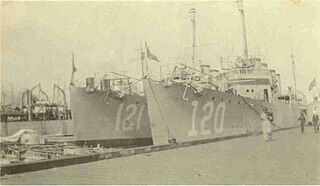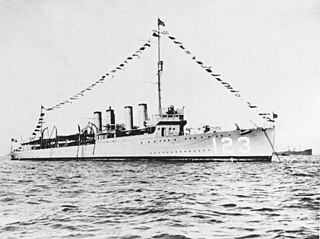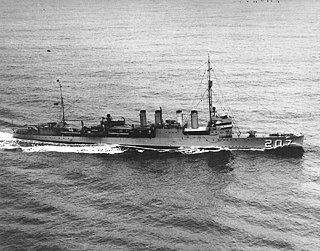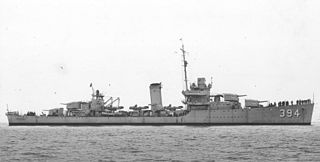
The third USS Farragut (DD-348) was named for Admiral David Glasgow Farragut (1801–1870). She was the lead ship of her class of destroyers in the United States Navy.

The second USS Cummings (DD-365) was a Mahan-class destroyer in the United States Navy, named for Andrew Boyd Cummings. She was a Pacific-based vessel, performing patrol and escort duties before and during World War II. The ship was present during the Attack on Pearl Harbor by the Japanese on 7 December 1941, though she escaped major damage or casualties. Cummings was decommissioned in 1945 and sold for scrap in 1947.

USS Montgomery (DD–121) was a Wickes-class destroyer in the United States Navy during World War I, later reclassified DM-17. She was the fifth ship named Montgomery and was named for Rear Admiral John B. Montgomery.

USS Gamble (DD–123/DM-15) was a Wickes-class destroyer in the United States Navy during World War I, later converted to a minelayer in World War II.

USS Ramsay (DD-124) was a Wickes-class destroyer in the United States Navy during World War I, reclassified as DM-16 during World War II and again reclassified as AG-98. She was the first ship named for Rear Admiral Francis Ramsay.

USS Southard (DD-207/DMS-10) was a Clemson-class destroyer in the United States Navy during World War II. She was the second Navy ship named for Secretary of the Navy Samuel L. Southard (1787–1842).

USS Tracy (DD-214/DM-19) was a Clemson-class destroyer in the United States Navy during World War II. She was the only ship named for Secretary of the Navy Benjamin Franklin Tracy.

The first USS Clark (DD-361) was a Porter-class destroyer in the United States Navy. She was named for Charles E. Clark.

The third USS Reid (DD-369) was a Mahan-class destroyer in the United States Navy before and during World War II. She was named for Samuel Chester Reid, a U.S. Navy officer in the War of 1812 who helped design the 1818 version of the flag of the United States.

USS Lardner (DD-487), a Gleaves-class destroyer, was the second United States Navy ship to be named for Rear Admiral James L. Lardner, a Naval officer during the American Civil War. Lardner received 10 battle stars for World War II service.

The second USS Sampson (DD-394) was a Somers-class destroyer in the United States Navy. She was named of William Thomas Sampson a rear admiral known for his victory in the Battle of Santiago de Cuba during the Spanish–American War.

USS O'Brien (DD-415) was a World War II-era Sims-class destroyer in the service of the United States Navy, named in honor of Captain Jeremiah O'Brien and his five brothers, Gideon, John, William, Dennis and Joseph, who captured HMS Margaretta on 12 June 1775 during the American Revolution.
USS PC-1136 was a PC-461-class submarine chaser built for the United States Navy during World War II. Shortly after the end of the war, she was renamed USS PCC-1136 when she was reclassified as a combat communications control ship. In 1956, she was renamed Galena (PC-1136), becoming the third U.S. Navy vessel so named, but never saw active service under that name.
USS PC-1141 was a PC-461-class submarine chaser built for the United States Navy during World War II. She was renamed USS Pierre (PC-1141) in 1956, was decommissioned from the U.S. Navy in October 1958, and transferred to the Indonesian Navy as KRI Tjakalang.
USS Adroit (AM-82/PC-1586) was an Adroit-class minesweeper acquired by the United States Navy for the task of removing mines that had been placed in the water to prevent the safe passage of ships.
USS Advent (AM-83) was an Adroit-class minesweeper of the United States Navy. The ship was laid down on 18 August 1941 at Portland, Oregon, by the Commercial Iron Works; launched on 12 March 1942; and commissioned on 19 August 1942.
USS Conflict (AM-85) was an Adroit-class minesweeper of the United States Navy. The ship was launched on 18 April 1942 by Commercial Iron Works, Portland, Oregon; and commissioned 7 September 1942.
USS Constant (AM-86) was an Adroit-class minesweeper of the United States Navy. Laid down on 21 February 1942 by the Commercial Iron Works, Portland, Oregon, and launched on 9 May 1942, the ship was commissioned on 21 September 1942.
USS Daring (AM-87) was an Adroit-class minesweeper of the United States Navy.

USS PGM-8 was a PGM-1 class motor gunboat that served in the United States Navy during World War II. She was originally laid down as a SC-497 class submarine chaser on 2 November 1942 by the Wilmington Boat Works in Wilmington, California and launched on 1 May 1943. She was commissioned as USS SC-1366 on 12 August 1943. She was later converted to a PGM-1 class motor gunboat and renamed PGM-8 on 10 December 1943. After the war she was transferred to the Foreign Liquidations Commission in May 1947. Her exact fate is unknown.












